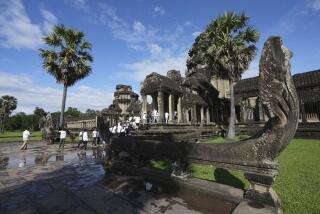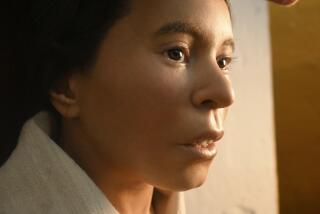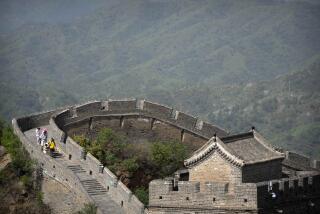Archeologist Finds Mayans’ Largest, Oldest Sculpture
- Share via
The oldest and largest architectural sculpture from the Mayan civilization yet discovered has been found by UCLA archeologist Richard Hansen in the Guatemalan site called Nakbe.
The massive head of the bird-god Itzam-Ye was sculpted on the side of one of the first pyramids built in Nakbe and later mysteriously hidden from view by a stone-and-earth terrace. The carved-stone head is 34 feet wide by 16 feet high and covered with painted stucco.
The monument is one of the first large examples of religious sculpture and reinforces the growing idea “that religion was the final major catalyst to propel the ancient Mayan culture into a full-blown civilization,” said Hansen, who is scheduled to formally announce his find today.
It dates from around 300 BC, “about 200 years earlier than most of the other known examples of similar sculptures,” Hansen said. “This work dates from an era in Maya development which we had not thought could have produced such a sophisticated construction.”
Archeologist David Friedel of Southern Methodist University said, “The discovery at Nakbe confirms the early importance of this royal capital in Mayan civilization. “We may be looking at the beginning of a great tradition of religious architecture.”
Taken together with other findings at the site over the last few years, the excavations at Nakbe are providing crucial information about the very beginnings of the Maya civilization--”one of the most complex, advanced and elegant societies in the ancient world,” according to Hansen.
Nakbe lies in the isolated central state of Peten, in the dense tropical forest in northern Guatemala. Although archeologists had long suspected that ruins lay at Nakbe, the forests prevented excavations until 1989, when Hansen reported the discovery of a large city.
He found that construction began at Nakbe as long ago as 630 BC, making it the oldest Mayan city. Previously, the most sophisticated artifacts from that era had been crude villages with low stone platforms measuring about six feet tall.
It is clear that the initial impetus for city building was to combat the harsh environmental conditions, Hansen said.
The nearest potable water, for example, was several hours away, and the Maya had no beasts of burden to transport it. So they built large stone structures to collect rainwater and funnel it into reservoirs.
Similarly, they had to build massive causeways, six feet high and as much as 6,000 feet wide, to traverse the swamps in the area. Trade had to be organized to bring in valuable seashells from the coast and obsidian from the highlands. These projects had to be administered, which led to the formation of a government and a ruling elite.
But the buildings constructed during the first 300 years at Nakbe did not have “monumental architecture,” Hansen said. They were functional and “basically barren.” Pyramids were small and had a single summit, like those excavated at other sites in Guatemala.
But about 300 BC, he said, “there was a massive transformation of Mayan society. They started constructing huge pyramids . . . with three summits” rather than one. The three summits, Friedel said, may represent the three stones on which the “First Father” of Mayan religion created the universe.
It was on the side of one of the first of these later pyramids that Hansen found the sculpture of Itzam-Ye, which is also known as the Principal Bird Deity.
His team had no idea the mask was there, Hansen said. Workers were excavating through a terrace on one side of the pyramid to learn more about its construction so that they could learn how to stabilize the pyramid for future generations.
“When we came across this snout, it was obvious something was there,” he said. “With a minimal amount of excavation, we revealed this entire, elaborate facade.” Much of the original coloring was still there, he said. “It’s mostly green, with a lot of red and black lines painted on it.”
Hansen believes that the sudden appearance of such religious imagery reflects the Mayan leaders’ attempts to use their people’s religious beliefs to consolidate their own authority and enlarge their power. By incorporating religious components into the buildings, the leaders were able to elicit voluntary labor for their construction, as well as monetary support.
That decision to incorporate religious images coincided with the start of a massive increase in the size and number of pyramids and other structures in the cities. “Religion appears to have been the final major ingredient for the formation of the complex Mayan civilization,” Hansen said.
Not everyone accepts Hansen’s interpretation. UC Berkeley archeologist John Graham, for example, praised the discovery of the sculpture, but argued that archeologists “place too much stress on religious interpretations” of things they do not fully understand. He suggested that the bird figure may be the totem of a ruling family rather than a god.
Hansen, however, noted that similar images have been found throughout the region and may be a holdover from the Olmec society, which preceded the Maya and lived primarily in Mexico. “It’s very clear that the protagonist that was depicted was of supreme importance to the ancient Maya,” he said.
Still unanswered are the questions of when and why the mask-like face was so carefully hidden. “We find many examples of other sculptures that were built over by subsequent generations of Maya with no attempts to save them,” Hansen said. “For some reason we have yet to explain, this sculpture was not only saved from destruction, but it was also concealed to preserve it.”
If research can reveal why the sculpture was hidden, he concluded, then the role of ideology in the formation of the Mayan civilization may become much clearer.
A Major Mayan Find
UCLA archaeologist Richard Hansen has found the oldest and largest architectural sculpture from the Mayan empire at the recently discovered city of Nakbe in northern Guatemala. The Sculpture
Material: Stone, covered with painted stucco
Subject: A god called the Principal Bird Deity, or Itzam-Ye.
Date: 300 BC
Importance: Sculpture dates from an era of Mayan history that was not thought capable of such sophisticated construction. Archeologist Hansen believes it illustrates the significance of religion in creating the Mayan civilization.
More to Read
Sign up for Essential California
The most important California stories and recommendations in your inbox every morning.
You may occasionally receive promotional content from the Los Angeles Times.










